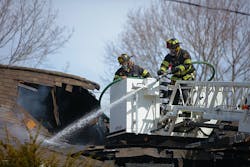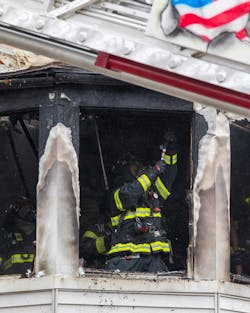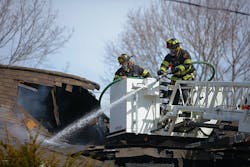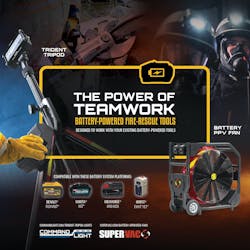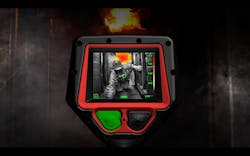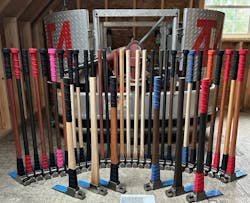A tactic that we use beyond fire knockdown on the fireground that can save lives and property and instill positive public relations is overhaul. However, in high fire areas, people can get nervous when they see firefighters with their “wrecking sticks” and conclude that members are on a search-and destroy mission.
Firefighters who seek to operate with the utmost professionalism should consider that they are operating in someone’s home and amid all of that person’s possessions. Any care that members can take to preserve those possessions means a lot. This can be as simple as taking the photograph of Great Grandma off of the wall and placing it in a dresser drawer before you open the lath and plaster wall and ceiling, to prevent destroying the photograph.
Another option is removing windows quickly and efficiently by using the tabs prior to opening the walls and ceiling rather than hitting those multiple times with a Halligan. We know how the sound of breaking glass is contagious and usually sets off a chain reaction. There’s a time and place to do this, but it usually looks bad when the fire is under control. If we do choose to do this, we should clean the window and trim the glass, so what remains is an unobstructed window and not a porthole.
Awareness of construction type
We also must understand basic building construction in relation to voids and fire spread. Know whether the building is balloon-frame construction with no fire stops, which allows for unimpeded vertical and horizontal fire spread, or platform construction, which has fire stops. If you aren’t sure, pop off a section of baseboard molding on an exterior wall to see whether there’s a void going to the floor below. This is easily done with a Halligan or hook.
With the use of lightweight truss construction, you can have horizontal and vertical fire spread on multiple floors through the truss loft and not just on the top floor. An effortless way to detect this is to open the ceiling with a hook upon entering the fire area doorway.
When operating in a kitchen or bathroom fire with possible extension into the cabinets or pipe chase, you must check the pipe chase using a Halligan or hook to see whether there’s any extension above or below. When there’s extension, you might be able to use a water extinguisher or a pot or wastebasket of water to slow the spread of fire while you await a charged hoseline to get into position.
A dumbwaiter shaft might have been used to run wires to multiple floors of a residence. Fire can spread via the shaft. Avoid placing your body inside of the shaft, in case the dumbwaiter car is in there, which can be a hazard.
Bathrooms, closets & roofs
When operating in older multifamily dwellings and overhauling the walls and ceiling, the bathroom floor isn’t a good spot to stand. Years of water damage on the weakened floor beams and the added weight of a filled bathtub on a compromised floor can be a collapse hazard. You should stand outside of the bathroom and use a hook to open the walls and ceiling. Pulling the medicine cabinet out of the wall to see the pipe chase or wall behind is sound practice, too.
When operating inside of large multifamily dwellings, you want to be certain to check for enclosed I-beams, which usually are found in closets and corners of rooms. These can allow fire to spread horizontally and vertically.
When operating on the roof, make sure that there’s a fire wall to determine fire area and whether you have a boxed-out area. You can sound it with a Halligan to see whether it’s an enclosed I-beam, where fire can travel, or a brick fire wall, where fire should stop. In any case, you must check the area below, because plumbers and electricians could have breached this to run pipes or wires but failed to properly fire-seal them.
Commercial occupancies
When operating in a commercial occupancy, you should first open the ceiling inside of the entrance doorway by using a hook to check for fire and to identify the construction of the roof.
For opening tin ceilings, the Halligan hook with pry bar handle works well for exposing the seam where the tin is placed together and for making a purchase point with the pry bar handle.
When opening ceilings, you want to get to the roofboards or floorboards above. It’s common to have multiple ceilings. You want to expose the entire fire area, so everything must come down. For high ceilings, you might need an 8- or 10-foot hook. A 10-foot hook usually is easier to handle with two firefighters.
Fire origin
The key point to remember when overhauling is that you want to find the origin of the fire. This is accomplished by locating the V pattern as well as anything that could have been involved with ignition and the ignition source. From there, you open the walls and ceiling around this area, from the burnt area until you find the unburnt side.
If you find anything that’s suspicious or any evidence, try to preserve it by working around it. If that isn’t possible, you can remove the evidence, but be prepared to show the fire marshal where it was or to recreate the scene. Saving as much evidence as possible is particularly important if the fireground turns into a crime scene. Be ready to explain what you saw, smelled and did.
You also want to open bays that were involved by fire. You do this for the purpose of clearing all sheetrock or lath and plaster from the area. Don’t leave any wood lath or sheetrock. It can be a hazard if there are exposed nails or staples. Furthermore, it looks unprofessional.
A technique that helps you to open wood lath and plaster walls more easily is to make a hole in the wall with the hook or Halligan at waist level. The hole should be big enough to insert the hook shaft or the fork end of the Halligan into the bay. With the hook shaft or adze and the pike end of the Halligan, pull outward toward you. Use this leverage to pull the lath and plaster and expose the bay and each side that adjoins the bay.
This technique also works well for pulling ceilings where you have a ceiling height that’s less than the hook size. Six-foot hooks work well in private dwellings. You can make a small hole to insert the hook shaft into the bay and use the leverage to pull down the ceiling. This can be effective with two firefighters working in unison one or two bays apart from each other. You should get about five or six bays down this way. This accomplishes the task quickly, and members don’t expend as much energy as they might when they work alone.
Another tip: Firefighters often will place their tool on the ground and open the ceiling. This can result in them burying their tool. An effortless way to avoid this is to take the pike end of the Halligan and spike the Halligan into the wall at about shoulder height. This is done so that the ceiling debris falls onto the floor and your Halligan is safe in the wall and at arm’s reach. Some manufacturers even design the hook so that it can be mated with the Halligan, so you can pull the ceiling with the tools mated.
Hydraulic overhaul
When we get the occasional big burner, it’s better to just hydraulically overhaul with the tower ladder and to let the water monster do what it’s designed to do instead of putting firefighters at risk.
Using a straight-tip nozzle and a stream shaper and decent pressure to penetrate and quench the fire, strip roofing and siding for the purpose of exposing any hidden fire. If needed, you can hydraulically demolish the building.
When using the tower ladder or any streams to hydraulically overhaul, it’s important to monitor runoff. You should have as much water coming out as you are putting in. If not, where is the water going? Are the contents absorbing it? Is the water over the windowsills? Do you have a collapse zone setup?
Product Highlights
Optimizing Space
Make the most of truck design with same-battery-platform tools. Specify on-board charging stations and arrange tools together, for easy accessibility to tools and their batteries. Super Vac’s battery fans and Command Light’s Trident Tripod run off the industry’s favorite nonproprietary batteries: DeWalt, HURST, Makita and Milwaukee.
Thermal Imaging Camera
The Seek AttackPRO combines a high-resolution 320 x 240 thermal sensor with enhanced clarity and detailed coloration in a robust, heat-resistant housing to aid in decision-making for captains and commanding officers via quicker and more precise size-up of structures. This provides greater efficiency to find the seat of the fire, conduct primary search and direct water.
Multipurpose Hand Tool
The MetroAdze is designed for forcible entry, opening walls and roofs, and conducting overhaul. It weighs 5 lbs., 6 oz. and has a 36-inch hickory handle. (A model for officers has a 30-inch handle.) The adze measures 6 x 2 inches. Customization includes engraving of unit patches, names and badges and hockey tape grips.
TICs & Overhaul
A thermal imaging camera (TIC) comes in handy with overhauling. However, there can be limitations based on the camera and technology that it uses. Make sure that you know your limitations. Also consider heat and/or hot water pipes that might be in the wall.
A good tactical tip for using the TIC is to use it so that the long side of the display faces up and down. This allows you to see floor to ceiling on the display, so you can monitor conditions in the room and direct others.
Of course, you can use the back of an ungloved hand to check for heat, too.
It always is better to be safe and spend an extra 20 minutes opening to make sure that “steam” isn’t really a hot spot that’s smoldering. It never is fun to go back to the same place where you were earlier and find that nasty “R” word—rekindle.
About the Author
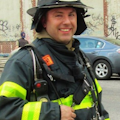
Charles Hendry
Charles Hendry has more than 33 years of experience in the fire service. He is a lieutenant in the FDNY Special Operations Command assigned to Squad 252, chief of training for the Hempstead, NY, Fire Department and a 33-year member of Harper Hook & Ladder Company 1. Hendry is a New York State Fire Instructor 2 and a deputy chief instructor at the Nassau County Fire Service Academy and the FDNY Technical Rescue School.
